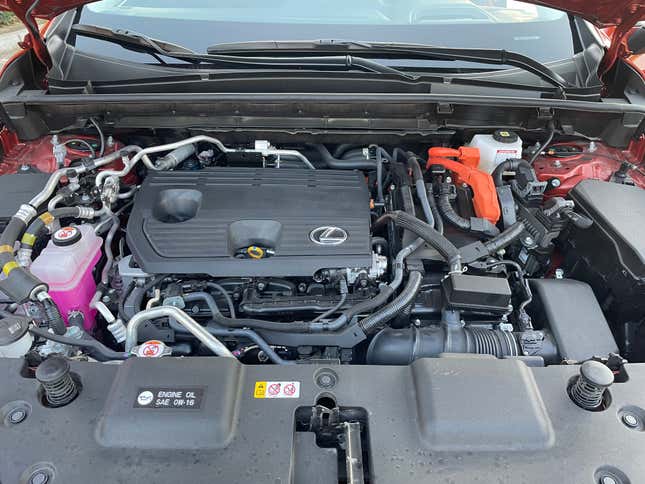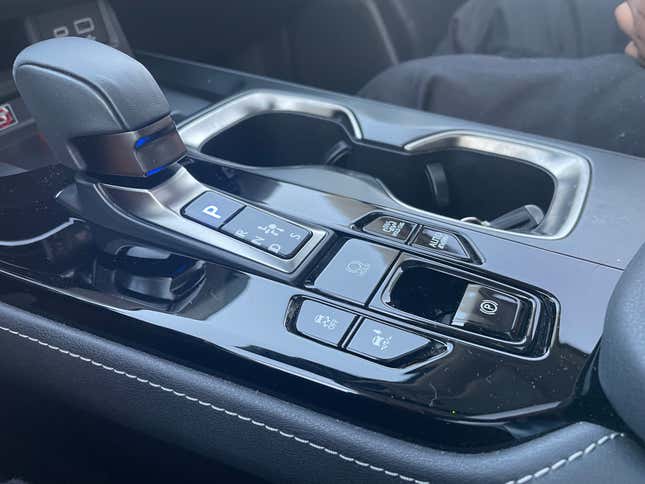Plug-in hybrids are a great compromise for people that still want the convenience of a gas car but want to experience the benefits of electrification. Most PHEVs have enough electric driving range to cover commutes and around-town needs while the gas engine alleviates any range anxiety. After years of making excellent hybrids, Lexus is finally getting in the plug-in hybrid game with the NX450h+. It combines the luxury and functionality of the second-generation NX with usable electric power. But it comes at quite a price.
Disclaimer: Lexus offered me the NX450h+ and I was actually surprised at how much I enjoyed it. Filling up the tank only once a week is great.
What Is It?

The NX is Lexus’ second-smallest crossover, slotting above the UX and below the RX. While it rides on a modular platform that’s shared with everything from the Toyota Sienna minivan to the Lexus ES sedan, the NX is more mechanically related to the Toyota RAV4. This is an important point that I’ll get to later. And if you’ve always wondered what the hell NX stands for, a Lexus rep once told me it means “Nimble Crossover.” Alright.
Specs That Matter

Power comes from the same 2.5-liter naturally aspirated I4 engine that powers the base NX250 and the NX350h hybrid, but the difference is in the electric setup. The 450h+ adds a pair of electric motors that drive the rear wheels, giving this SUV all-wheel drive. Add in an 18.1-kilowatt-hour lithium-ion battery pack powering those motors and the result is the most powerful and efficient NX you can buy. It makes 304 total system horsepower with 364 lb-ft of torque. It also gets 84 mpge – the mile-per-gallon equivalent of gasoline and electric driving – and can go 37 miles on electricity alone. Honestly, though, it’s actually pretty easy to beat the EPA’s estimated EV range. I frequently saw as much as 42 miles of electric range per charge.
How It Drives
Lexus likes to tout the NX450h+ low center of gravity, and indeed, this thing is surprisingly nimble. It’s also surprisingly quick, with plenty of acceleration power for highway merging. The perk of having a battery and electric motors at your disposal is that, in everyday driving, it’s like having a turbo that’s always ready to provide extra boost. Power comes on smoothly and quickly, and the transition between gasoline and electric driving is one of the smoothest I’ve ever experienced. Unfortunately, when you’re relying on the 2.5-liter engine for power, it sounds buzzy and unrefined.
What’s great about crossovers this size is how easy they are to maneuver. Parking and getting through tight spots is pretty easy. Parking the NX is made even better thanks to Lexus’ Advanced Park system, which is easier to operate than most other automated parking systems I’ve used. I also have to give Lexus props for placing a physical button on the dash to turn on the Advanced Park tech. There’s no having to line up in a specific spot for the system to self-engage. You simply find the spot you want, press start on the screen and let the car park itself. The system can pull forward, back in, or perform parallel parking maneuvers.

Driving in different powertrain modes is just as easy. A button on the center console allows drivers to choose between full-on EV mode, Hybrid or Charge setting, the latter of which uses the gas engine to recharge the battery while you’re driving. In EV mode, the NX450+ is predictably quiet. In Hybrid mode, the drivetrain operates as any other hybrid would, defaulting to electric power as often as possible with the gas engine kicking on as needed.
Charging at home is easy. The NX has an optional 6.6-kilowatt onboard charger ($800) that you simply plug into a standard home outlet. Charging this way, it takes about 4 to 5 hours to fully replenish the battery. It’s a cinch to do overnight. Unfortunately, public charging on a Level 2 outlet is a hit-or-miss affair, but that’s a product of the country’s problematic charging network, not Lexus.
A Few Notable Pros and Cons of the NX450h+

The NX has a lot of useful safety systems, but some of them are super sensitive. The pre-collision braking, for example, will sometimes activate when there’s no danger ahead of you. On the other hand, I like things like Safe Exit Assist, which will alert you to passing cars when you’re trying to exit from a parallel parking space. I just wish all of the systems were more cohesive in their integration.
The wireless charging pad doesn’t work well. It often doesn’t detect when a device is placed on top, and when it does work, the slippery surface means your phone moves around a lot when driving, which can cause it to stop charging.

The interior door handles are also unnecessarily complicated. The NX uses a dual electronic/standard door handle. At the forward end, you’ll find a braille-like surface that denotes where you should press to exit the car. Next to that, labeling shows how the handle operates manually, in case of power failure or an emergency. This is confusing and takes some getting used to, and seems like the answer to a question nobody asked.
Verdict

The NX450h+ is an impressive plug-in effort from a company known for its hybrid excellence. But it may end up being a tough sell to some. For starters, the NX450h+ isn’t cheap. While a regular NX250 starts at a rather reasonable $38,850, you’re looking at well-equipped RX money for the 450h Plus: $57,705. With nearly every option box checked, including a $1,075 destination charge, my orange NX450h Plus costs $62,090.
Now, remember when I said that the NX is mechanically related to the RAV4? The NX450h+ uses the same drivetrain setup as the Toyota RAV4 Prime, which is over $15,000 cheaper. Yes, the Lexus is a little nicer inside, but that’s a big jump in price for effectively the same experience.
None of this is to say that the NX450h Plus is bad. It’s actually very good. But having to drop nearly $60,000 on a compact crossover just for the ability to drive 40 miles on electricity alone is a hard sell, especially when the exact same setup can be had for less money.